here was a young lady who went on a spree.she carefully planned a game for three’ Confessions of a Psycho Cat updates the plot of The Most Dangerous Game to late Sixties New York, with all the exploitation movie sex and violence you’d expect from such a setting, along with gender- reversing the Count Zaroff role to tell the tale of a lethal female.
The Psycho Cat of the title is Virginia, a nervous breakdown prone Manhattan socialite who is ‘a little out-of-sorts’. Unable to join her brother on safari, Virginia decides to have a little safari of her own-hunting humans. The intended prey are Buddy a junkie drug dealer, Freeman a pompous actor, and Rocco a brutish, has-been, wrestler (played by former middle-weight boxing champion Jake LaMotta)- all three are offered $100,000 if they can survive in New York for 24 hours while Virginia and her mute handyman try to hunt and kill them. Why has Virginia choose these three men in particular? because they’ve all ‘accidentally’ killed in the past, Buddy overdosed a girl, the actor ended up slicing a love rival to death with a cut-throat razor, while the wrestler stomped an opponent to a bloody pulp- after some hesitation the men except Virginia’s offer.
The subsequent hunt scenes have a nightmarish quality that are worth the admission price alone, but Psycho-Cat scores best in the prelude to Virginia’s rampage as we delve into the private lives of her prey, three sad and understandably paranoid lowlifes. The junkie lays low at a drug and sex orgy populated by beatniks and women with outrageous wigs, the actor hides in his apartment like a frightened rabbit, and the wrestler spends the night with a $20 hooker, but with sadistic glee Virginia plays on their human failings to lure them into the open. The actor gets a call offering him the lead in a play, and ever the egoistical thespian this is an offer he can’t refuse, while Buddy’s drug habit dictates he would rather risk death than cold turkey, and the wrestler can’t stand the idea of being upstaged by a woman, a situation that winds him up so much the hooker gives him the twenty dollars back and throws him out. In all three cases Virginia gets to dish out her own brand of morality, the actor is run through with a sword; Buddy gets literally shot-up, while the wrester tracks down Virginia only to end up in the middle of a bullfight with him as the bull.
As the Psycho-Cat, Eileen Lord who vaguely resembles 60’s singer Esther Ofarim isn’t the sort of actress you can easily forget. Even from the outset its clear Virginia isn’t exactly normal and as Psycho Cat progresses, the filmmakers lap-up Lord’s hammy attempts at evoking delirium- with some incredible close-ups of her pulling the sort of gargoyle expressions its hard to believe a human face can make. The casting of Jake LaMotta is an equally inspired touch, it’s fascinating to compare the worse-for-wear LaMotta preserved for prosperity in Psycho Cat, to the way DeNiro later portrayed these leaner years in Raging Bull. In scenes where his character sits shirtless screaming down the phone ‘I am the champ’ its almost as if LaMotta is acting in his own, personal Raging Bull. On a trivia note, LaMotta isn’t credited in the cast list, but by the time the film was re-released as ‘3 Loves of a Psycho-Cat’ his name and boxing legacy featured heavily in the advertising. No one has ever uncovered the story behind Psycho Cat’s creation, but judging by the end-result it must be a fascinating little tale. The released version is very much a cut and paste job, telling its convoluted tale in flash-backs and flash-forwards that don’t quite match with each other, there’s also lots of soft-core nudie scenes, very detached from the narrative that were clearly shot to sex-up the film’s commercial appeal, while plot-diversions explaining how Buddy, Freeman and Rocco came to be murderers and murdered feel like six separate films unto themselves. The DVD notes speculate Psycho Cat was shot as a plain old horror movie with the soft-core filmed a few years later, although the film could equally have been the work of multiple directors shooting the same film simultaneously, even if they weren’t exactly singing from the same song-sheet. That these directors- ‘Eve’ and ‘Herb Stanley’ remain mysterious if not pseudonymous figures, only adds to Psycho Cat’s appeal and whereas most cut and paste films are only interesting for the glimpses of what they could have been, and the incoherent messes that they usually are, Psycho Cat manages to hold its multilayered plot together surprisingly well. The film also gets top-notch mileage out of its settings, with wonderful shots of LaMotta snorting his way through night-time New York, the junkie prowling the streets looking for a toilet to call home, and most audacious cross-bow carrying Virginia running around Manhattan in fox hunting togs, something that must have earned the filmmakers some odd-looks from passers-by.
For a film no-one appears to have heard of till recently Psycho Cat seems to have had quite a longevity on the US sexploitation circuit. It even played in the UK sometime in the early Seventies- too strong for the UK censor showings were restricted to ‘membership only’ sex cinemas- Psycho Cat played exclusively on the Cinecenta-cinema-chain which fed post-swinging Londoners a diet of more darker US exploitation fare like Bad Girls Go to Hell, The Filthy Five, Sex Killers Incorporated, and the charmingly monickered Sinful Kinfolk which played as a support feature to Psycho Cat. These days you can view Psycho Cat in less clandestine ways (its played on late night UK television and has surfaced on DVD in the US) but the violent, kinky nature that gave the film its initial fascination remains undiminished. A unique, stand-alone piece of work, Psycho Cat deserves its current popularity, as do its makers whoever they were.

